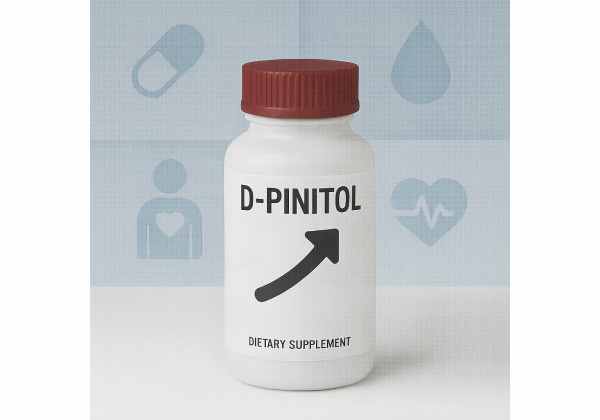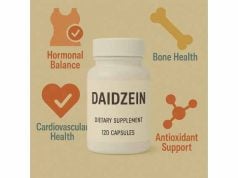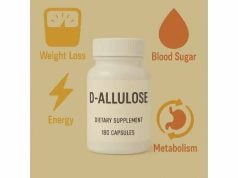
D-pinitol is a naturally occurring cyclitol (3-O-methyl-D-chiro-inositol) found in carob pods, soy, and certain pines. As a close relative of the inositols, it has drawn interest for metabolic health—especially insulin sensitivity, post-meal glucose responses, and liver fat. Early animal and cell research suggested “insulin-mimetic” actions, while small human studies explore blood sugar, lipids, and liver enzymes. A notable randomized trial in non-alcoholic fatty liver disease (NAFLD) showed improvements in liver fat and oxidative stress markers with 300–500 mg/day. Meanwhile, a recent pharmacokinetic study mapped how D-pinitol is absorbed and how it influences hormones like insulin and ghrelin. The bottom line: D-pinitol looks promising, but it is not a drug, evidence in some areas remains mixed, and it works best alongside nutrition, movement, and medical care when needed.
Quick D-Pinitol Highlights
- Supports insulin sensitivity and post-meal glucose control in small human trials; strongest clinical signal is in NAFLD.
- May aid liver health at 300–500 mg/day over ~12 weeks; effects vary by person and baseline diet.
- Can lower insulin levels and modestly affect hormones in acute dosing; not a substitute for prescribed diabetes therapy.
- Typical supplemental range: 300–600 mg/day, usually with meals; some studies used single doses of ~15 mg/kg.
- Avoid if pregnant or breastfeeding (insufficient data) or if you use glucose-lowering drugs without medical supervision.
Table of Contents
- What is D-pinitol and how it works
- Proven and possible benefits
- How to use it day to day
- Dosage: how much per day
- Safety, interactions, and who should avoid
- Mistakes to avoid and troubleshooting
- What the evidence says today
What is D-pinitol and how it works
D-pinitol is a plant-derived cyclitol—chemically, 3-O-methyl-D-chiro-inositol (DCI). It occurs naturally in carob (Ceratonia siliqua), soy, and some conifers, where it helps plants manage osmotic stress. In humans, D-pinitol belongs to the broader inositol family, a group of glucose-like molecules that serve as building blocks for inositol phosphoglycans, intracellular messengers involved in insulin signaling. Because of this link, pinitol has been investigated as an “insulin-sensitizing” nutrient.
When taken orally, D-pinitol is absorbed over several hours, achieving peak blood levels around the 3–4-hour mark, with a half-life that often exceeds 5 hours. In a human pharmacokinetic study, single oral doses (for example, ~15 mg/kg) produced endocrine effects consistent with reduced insulin secretion and increased glucagon and ghrelin in fasting adults, without raising blood glucose. Those hormone shifts suggest a physiological “rebalancing” rather than a simple glucose-lowering spike. Interestingly, when D-pinitol is delivered as part of a sugary carob syrup, its peak concentration in blood drops compared with the same dose taken alone—likely because glucose and fructose compete for intestinal transport. Practically, this means the matrix (what you take it with) matters.
Mechanistically, several complementary actions are proposed:
- Insulin signaling support. D-pinitol (and its relative D-chiro-inositol) appears in pathways that help insulin move glucose into cells.
- Liver carbohydrate metabolism. Animal and cell data indicate effects on hepatic glycolysis and gluconeogenesis, which can stabilize fasting glucose.
- Antioxidant and anti-inflammatory activity. Preclinical models show lower oxidative stress and inflammatory signaling, factors that influence insulin resistance and fatty liver biology.
- Potential conversion and synergy. D-pinitol is a methyl ether of D-chiro-inositol. In some tissues and species, demethylation may increase DCI pools, though how much this happens in humans remains an open question.
Because D-pinitol is nutraceutical, context is crucial. Benefits tend to be modest and are most visible when insulin resistance, fatty liver, or post-meal glucose spikes are present. In healthy people with normal glucose control, measurable effects can be small or inconsistent. Finally, D-pinitol is not a replacement for first-line medical therapies; instead, think of it as a supportive tool within a broader lifestyle and clinical plan.
Proven and possible benefits
Metabolic health (insulin sensitivity and post-meal glucose). Small human trials and acute dosing studies suggest D-pinitol can help flatten post-prandial glucose curves and reduce circulating insulin after intake, especially when carbohydrates are present. The endocrine profile in fasting volunteers—lower insulin with stable glucose and higher ghrelin—hints at pancreatic “sparing” and improved insulin efficiency. However, not all studies are positive; an older, well-controlled trial in older adults found no improvement in insulin-mediated glucose metabolism after weeks of pinitol supplementation. These conflicting results likely reflect differences in population (insulin-resistant vs. healthy), dose, timing, and diet.
Liver fat and enzymes (NAFLD). The strongest clinical signal for D-pinitol is in non-alcoholic fatty liver disease. In a randomized, double-blind trial of adults with ultrasound-confirmed NAFLD, 300–500 mg/day for 12 weeks improved liver fat content, ALT/AST, and oxidative stress markers compared with placebo. Some lipid measures (like post-meal triglycerides) also improved. While a single trial cannot establish definitive therapy, the combination of hepatic and oxidative benefits places D-pinitol as a reasonable adjunct to diet, exercise, and weight management in NAFLD, pending clinician oversight.
Women’s health (PCOS context). Most robust data in PCOS involve myo-inositol and D-chiro-inositol, which can improve ovulatory function and metabolic parameters in many, though not all, analyses. Because D-pinitol is closely related to DCI, some practitioners consider it when insulin resistance coexists with cycle or fertility concerns. That said, direct, high-quality PCOS trials on D-pinitol itself are limited. If PCOS is your main goal, evidence currently favors myo-inositol (often with DCI) over pinitol—discuss options with your clinician.
Lipids and oxidative stress. Beyond liver enzymes, D-pinitol has shown modest improvements in triglycerides and reduced markers of oxidative stress in subsets of participants. The magnitude is usually small and depends on baseline diet and body weight. It should not be relied upon as a stand-alone lipid-lowering agent.
Appetite and hormonal milieu. Acute dosing can raise ghrelin, which could influence appetite signaling. Whether this translates into meaningful, long-term changes in hunger or weight is uncertain; data are preliminary.
Exercise and performance. Marketing sometimes pairs pinitol with creatine or carbohydrate blends to claim enhanced muscle glucose uptake. Evidence in trained humans is insufficient to recommend pinitol specifically for performance or muscle gain.
Bottom line: D-pinitol’s most credible benefits today are liver-related (in NAFLD) and select metabolic endpoints in insulin-resistant contexts. Effects vary, and expectations should be modest unless combined with diet, activity, sleep, and clinical care.
How to use it day to day
Pick a well-specified product. Choose brands that list D-pinitol per capsule/serving (e.g., 250 mg or 300 mg) and identify the source (often carob). Avoid proprietary blends that obscure the actual pinitol dose. If you’re considering pinitol specifically for NAFLD, look for products providing 300–500 mg/day to mirror trial doses.
Time it with meals you care about. Since pinitol’s most practical role is modulating post-meal responses and supporting insulin efficiency, take it with carbohydrate-containing meals where you want steadier glucose (breakfast or your largest meal). If you use a continuous glucose monitor or post-meal fingersticks, evaluate the same meal with vs. without pinitol for 1–2 weeks to see if it makes a measurable difference.
Combine with fundamentals. Pinitol will not overcome a pattern of large, refined-carb loads, chronic sleep restriction, or very low activity. Pair it with:
- Protein and fiber at meals to slow glucose absorption.
- Resistance training 2–3 times per week to improve insulin sensitivity.
- Walking 10–20 minutes after higher-carb meals.
Stacking with inositols (for PCOS or metabolic goals). If your main target is PCOS, current evidence supports myo-inositol (often 2–4 g/day) with or without D-chiro-inositol in a clinician-guided ratio. Pinitol may be considered if you tolerate it better or prefer lower capsule burden, but acknowledge the thinner PCOS evidence for pinitol itself. For general metabolic health, some users alternate pinitol on higher-carb days and use myo-inositol otherwise; this is reasonable but not clinically validated.
Pairing with other supplements. Reasonable companions include omega-3s (lipids), vitamin D (status-specific), and magnesium (glucose/insulin cofactor). Be cautious stacking pinitol with multiple glucose-lowering botanicals (berberine, cinnamon extracts, banaba) if you also use metformin, insulin, or sulfonylureas—coordinate with your prescriber.
Track what matters. Decide on 1–2 outcomes to watch for 8–12 weeks:
- For NAFLD: liver enzymes (ALT, AST, GGT) and, if possible, steatosis imaging per clinician.
- For metabolic goals: fasting glucose, A1c (if appropriate), and post-meal readings to the same meals.
- For symptoms: energy after meals, cravings, and GI tolerance.
Stop or reassess if no signal. If you see no meaningful change after 8–12 weeks at a suitable dose, de-escalate or discontinue and refocus on diet, activity, sleep, and medications with proven benefit.
Dosage: how much per day
Evidence-aligned ranges. Most commercially available products deliver 250–300 mg per capsule. Study-aligned total daily intakes typically fall between 300 and 600 mg/day, split once or twice daily with meals. For liver health (NAFLD), a 12-week randomized trial used 300 mg/day or 500 mg/day, with both doses showing favorable changes in liver fat and oxidative stress markers.
Single-dose physiology. Research in healthy adults has used single doses around 15 mg/kg (≈1,000 mg for a 70 kg person) to map absorption and hormonal effects. Those acute protocols are not “everyday” regimens, but they show pinitol’s time course (Tmax ~3–4 h; half-life >5 h) and endocrine profile (reduced insulin, increased glucagon/ghrelin without hyperglycemia) under fasting conditions. For daily use, stay within label directions unless supervised by a clinician.
Goal-based suggestions (practical, not prescriptive):
- General metabolic support or post-meal smoothing: 300 mg with your highest-carb meal; increase to 300 mg twice daily if tolerated and useful.
- Liver health adjunct (with clinician oversight): 300–500 mg/day for 12 weeks, reassessing liver enzymes and, when possible, imaging.
- PCOS context: Prioritize myo-inositol ± D-chiro-inositol per current evidence; if using pinitol, many mirror metabolic dosing (300–600 mg/day) while monitoring cycles and labs.
Who should start at the low end? People on metformin or insulin, those with reactive hypoglycemia, or anyone with sensitive GI tracts should begin at 300 mg/day, test tolerance for a week, then consider titration. Because co-ingestion with high sugar may blunt pinitol absorption, taking it with balanced meals (protein + fiber) is a reasonable default.
Forms and quality. D-pinitol is sold as standalone capsules or included in carob-based extracts. Both can work, but note that carob syrups with high glucose/fructose may reduce peak pinitol levels versus the same dose taken alone. Choose third-party-tested products where available.
Duration. For metabolic or liver goals, a trial of 8–12 weeks is a typical window to judge response. Long-term safety data are encouraging but still limited; periodic breaks and lab monitoring are prudent.
Safety, interactions, and who should avoid
General tolerance. D-pinitol is well-tolerated in human studies, with low rates of adverse effects at 300–600 mg/day. Occasional users report mild GI symptoms (bloating, soft stools) that usually resolve with food, dose reduction, or splitting the dose.
Glucose-lowering synergy. Because pinitol can reduce insulin levels and modestly support post-meal glucose handling, it may add to the effects of metformin, insulin, sulfonylureas, SGLT2 inhibitors, or GLP-1 receptor agonists. In well-controlled diabetes, this typically is not dangerous, but if you’re on insulin or secretagogues, there is a theoretical hypoglycemia risk. Monitor closely during the first 1–2 weeks, and coordinate with your prescriber about any dose adjustments of medications.
Blood pressure and lipids. No consistent blood pressure effects are reported. Lipids can improve slightly in some contexts (e.g., triglycerides in NAFLD) but not enough to replace statins or other indicated drugs.
Pregnancy and lactation. Insufficient data. Do not start pinitol during pregnancy or breastfeeding unless your obstetric clinician specifically endorses it for a rationale that outweighs unknowns.
Kidney and liver disease. If you have advanced kidney disease or chronic liver disease, discuss pinitol with your specialist before use. While hepatic endpoints in NAFLD improved in one trial, broader liver disease safety data are limited.
Allergies and intolerances. Pinitol is typically isolated from carob or soy. Finished supplements seldom contain allergenic proteins, but if you have soy or legume allergies, choose products with clear allergen statements and consider brands using non-soy sources.
Drug interactions of note.
- Antidiabetic medications: potential additive glucose-lowering—monitor.
- Thyroid, pituitary, or steroid therapies: no known direct interactions, but pinitol has minor endocrine effects in fasting conditions; consult your clinician if you take multiple hormonal agents.
Lab testing and follow-up. If you use pinitol for metabolic or liver goals, arrange baseline and follow-up labs (e.g., ALT, AST, GGT, fasting glucose, A1c, lipid profile). Discontinue and seek medical input if you experience dizziness, shakiness, or unusual fatigue suggestive of hypoglycemia.
Mistakes to avoid and troubleshooting
Expecting drug-level effects. Pinitol is not metformin, insulin, or a GLP-1 agonist. Improvements are generally modest and most noticeable when you also optimize diet quality, movement, and sleep.
Taking it with sugary syrups only. Pinitol absorption is lower when ingested in a high-sugar matrix (e.g., some carob syrups). If your goal is a meaningful blood level, prefer capsules or take pinitol with balanced meals rather than sugar-heavy drinks.
Using it for PCOS without considering inositol evidence. For PCOS, the evidence base is stronger for myo-inositol ± D-chiro-inositol than for pinitol itself. If cycles, ovulation, or fertility are your priorities, start where the evidence is clearest and reserve pinitol for specific metabolic adjunct goals.
Stacking without a plan. Combining pinitol with other glucose-active supplements (berberine, banaba, cinnamon extracts, bitter melon) plus medications can muddle your data and raise hypoglycemia risk. Add one variable at a time and track objective markers.
Skipping outcome tracking. Decide on measurable targets (e.g., two standardized post-meal glucose checks per week, ALT/AST at baseline and 12 weeks). If nothing changes, de-escalate—do not keep taking pinitol indefinitely out of habit.
Ignoring quality. Choose third-party tested products when possible. Avoid blends that bury pinitol in a proprietary mix without a clear milligram amount.
Troubleshooting tips:
- GI upset: take with meals; split 300 mg twice daily instead of 600 mg once.
- No effect after 8–12 weeks: verify dose (≥300 mg/day), timing (with meals), and diet (protein + fiber). Consider shifting to myo-inositol for PCOS goals or focusing on resistance training for insulin sensitivity.
- Variable meal responses: keep meal composition stable when testing; add post-meal walks which reliably lower glucose excursions.
What the evidence says today
The contemporary evidence base for D-pinitol divides into three pillars:
- Human pharmacology and acute physiology. Controlled studies in healthy volunteers establish that oral D-pinitol is absorbed, long-lived enough to matter (half-life >5 h), and alters hormones (lower insulin, higher glucagon and ghrelin) under fasting conditions without raising glucose. These findings support the idea that pinitol promotes insulin efficiency and may protect pancreatic workload.
- Clinical outcomes in targeted populations.
- NAFLD: A 12-week randomized, double-blind, placebo-controlled trial using 300–500 mg/day found improvements in liver fat, transaminases, oxidative stress, and post-prandial triglycerides. This is the most persuasive disease-specific signal so far.
- Insulin resistance and glucose metabolism: Results are mixed. An older, carefully designed trial in older adults showed no benefit on insulin-mediated glucose metabolism after supplementation, while other small studies indicate improvements in post-prandial glucose or insulin dynamics. Heterogeneity in participants, dosing, and timing probably explains discrepancies.
- Mechanistic and related-compound evidence.
- Inositols in PCOS: Systematic reviews and meta-analyses generally support myo-inositol and D-chiro-inositol for ovulation and metabolic markers, though recent guideline-linked analyses caution that overall certainty is low to moderate and effects vary. D-pinitol, as a methylated DCI, is biologically adjacent—but direct high-quality PCOS trials of pinitol remain sparse, so in PCOS it’s reasonable to prioritize MI/DCI first.
- Preclinical models: Animal and cellular work shows effects on hepatic glucose handling, oxidative stress, and signaling cascades consistent with modest metabolic benefits.
Practical interpretation. If your goals involve fatty liver or post-meal smoothing in an insulin-resistant context, D-pinitol at 300–500 mg/day for 8–12 weeks is a rational trial, paired with diet and movement. For PCOS, follow current clinician guidance emphasizing myo-inositol ± DCI; consider pinitol only as an adjunct if you tolerate it better or have specific metabolic reasons. And for anyone on glucose-lowering medications, monitor closely at initiation to avoid lows.
Research gaps. We still need:
- Larger, longer multicenter RCTs comparing pinitol with standard care in NAFLD and type 2 diabetes.
- Direct head-to-head trials of pinitol vs. myo-inositol/DCI for PCOS and metabolic endpoints.
- Studies clarifying conversion between pinitol and D-chiro-inositol in humans and how meal matrix or gut microbiota alter efficacy.
Until then, use pinitol deliberately: match the dose and timing to your goal, track outcomes, and integrate it within an evidence-based lifestyle and medical plan.
References
- Pharmacokinetics and Endocrine Effects of an Oral Dose of D-Pinitol in Human Fasting Healthy Volunteers 2022 (Human PK/Endocrine)
- Pinitol consumption improves liver health status by reducing oxidative stress and fatty acid accumulation in subjects with non-alcoholic fatty liver disease: A randomized, double-blind, placebo-controlled trial 2019 (RCT)
- D-Pinitol-Active Natural Product from Carob with Notable Insulin Regulation 2022 (Review)
- Pinitol supplementation does not affect insulin-mediated glucose metabolism and muscle insulin receptor content and phosphorylation in older humans 2004 (RCT)
- Inositol for Polycystic Ovary Syndrome: A Systematic Review and Meta-analysis to Inform the 2023 Update of the International Evidence-based PCOS Guidelines 2024 (Systematic Review/Meta-analysis)
Disclaimer
This guide is educational and is not a substitute for personalized medical advice, diagnosis, or treatment. Always talk with your healthcare professional before starting, stopping, or combining supplements—especially if you have a medical condition, take prescription medications (for example, insulin or other glucose-lowering agents), are pregnant, or are breastfeeding.
If you found this article useful, consider sharing it with friends or colleagues on Facebook, X, or your preferred platform, and follow us for future updates. Your support helps us keep producing careful, evidence-based content. Thank you.










